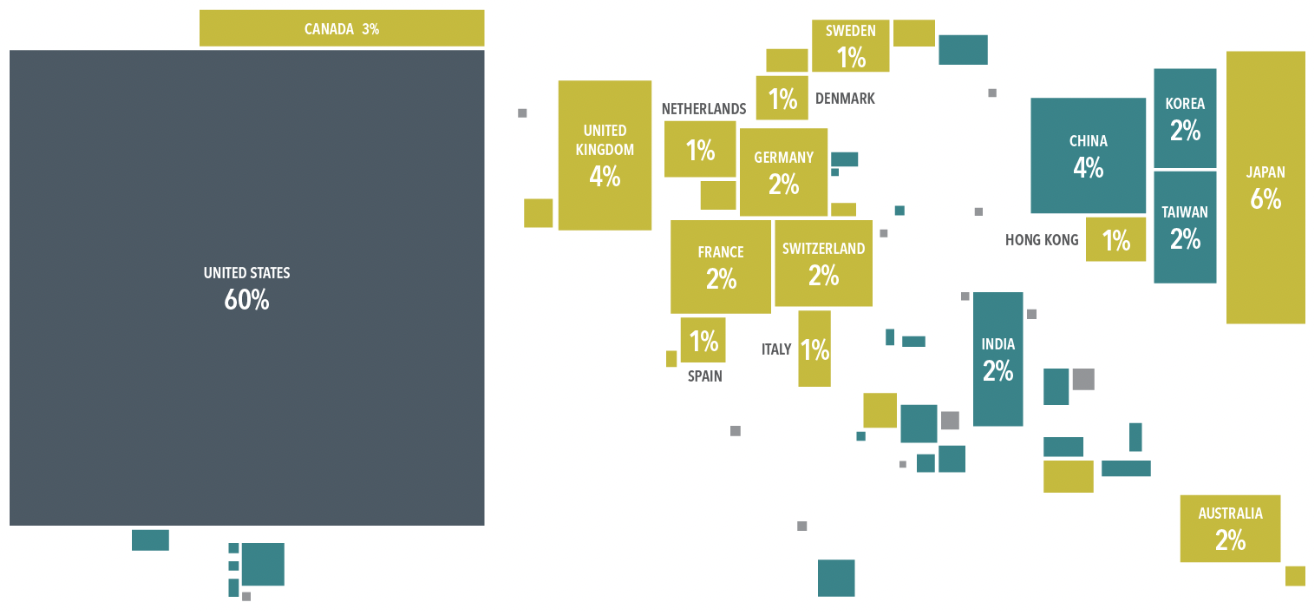
Go Global for Diversification That Travels Well
Investing Behavioral PlanningUS-based investors may believe they know America best. Accordingly, they are liable to put the bulk of their investments in stocks and bonds of US-based companies and in US federal and municipal fixed income securities. Given the size and relative safety of this market, that may seem a sound approach. Yet this strategy has some holes. “Home bias”1 can limit your investment opportunities and constrain your ability to benefit from diversification.
Consider these revealing numbers:
- The US stock market is the biggest in the world,2 but stocks of the roughly 18,500 companies trading outside the US represent nearly 40% of the world’s $88 trillion equity market (see Exhibit 1).

- The investment-grade bonds in the Bloomberg Global Aggregate Bond Index are valued at more than $68 trillion—and most of this debt is issued outside the US (see Exhibit 2) and in currencies other than the US dollar.

Global Ups and Downs
When Americans invest outside the US, they can capture equity returns from thousands of companies around the globe and potentially offset weak performance in one market with stronger returns elsewhere. Returns in 20225 offer a useful example of this phenomenon: The US stock market tumbled 21.3% (through June), but non-US developed markets like the UK (–8.8%) and Hong Kong (–2.9%) performed much better. And, in two examples from emerging markets, Chile soared 8.9% and Turkey gained 0.5%. Similarly, in fixed income markets, both yields and total returns typically vary across the globe and often do not move in lockstep, which is no surprise. Bonds issued in different countries and currencies can offer a range of yields and expected returns.
The Paradox of Size
A country’s size, population, or gross domestic product doesn’t necessarily tell us much about the investment opportunities in that country. Japan, for instance, is relatively small in landmass but accounts for 6% of the world’s equity market value—representing more than 2,500 companies, including familiar names like Toyota and Sony—as well as 13% of the investment-grade bond market. Even a tiny country like Switzerland is home to publicly traded giants like Nestlé and two of the world’s biggest pharmaceutical firms.
By looking outside their home market, investors can expand their choices and opportunities for higher expected returns. A global approach can also enhance diversification, which may help reduce portfolio risk and volatility. This isn’t guaranteed to produce strong returns every year, but it can deliver more reliable outcomes over time, helping investors stay on track toward achieving their long-term goals.
Wondering if your portfolio and plan could benefit from further diversification? We can help - schedule a call today!
More From Our Site
Important Details on Student Loan Relief
The Intersection of Money and Spirituality with Fr. Nick Hamilton
Social Security and Your Spouse
1For more information on home bias, see the following: “Home Bias,” Corporate Finance Institute, September 18, 2020; Eduard Gaar, David Scherer, and Dirk Schiereck,“The Home Bias and the Local Bias: A Survey,” Management Quarterly Review 72 (November 2020), 21–57; “The Randomness of Global Stock Returns” (Dimensional Fund Advisors, June 2019; “Home Bias and Global Diversification” (Dimensional Fund Advisors, December 2017).
2Based on the free float-adjusted market capitalization.
3In USD. Market cap data is free float-adjusted and meets minimum liquidity and listing requirements. Dimensional makes case-by-case determinations about the suitability of investing in each emerging market, making considerations that include local market accessibility, government stability, and property rights before making investments. China A-shares that are available for foreign investors through the Hong Kong Stock Connect program are included in China. 30% foreign ownership limit and 25% inclusion factor are applied to China A-shares. Many nations not displayed. Totals may not equal 100% due to rounding. For educational purposes; should not be used as investment advice. Data provided by Bloomberg.
4In USD. Data is from Bloomberg Global Aggregate Bond Index. Index excludes non-investment-grade securities, bonds with less than one year to maturity, tax-exempt municipal securities, linked bonds, and floating-rate issues. Treasury sector includes both nominal and inflation-linked native currency debt issued by central governments, which are backed by full faith and credit of a central government. Government-related sector groups are issuers with government affiliations, including agencies, sovereigns, supranationals, and local authorities. Corporate sector categorizes issuers based on primary lines of business, revenue streams, and operations used to service debt, including industrials, financial institutions, and utilities. Securitized sector is designed to capture fixed income instruments whose payments are backed or directly derived from pool of assets protected or ring-fenced from credit of particular issuer (either by bankruptcy remote special purpose vehicle or bond covenant). Underlying collateral for securitized bonds can include residential mortgages, commercial mortgages, public sector loans, auto loans, or credit card payments. Many nations not displayed. Totals may not equal 100% due to rounding. For educational purposes; should not be used as investment advice. Data provided by Bloomberg.
5MSCI country index performance, year to date as of June 30, 2022. MSCI data © MSCI 2022, all rights reserved.
This information is intended for educational purposes and should not be interpreted as investment advice.
The securities identified do not represent all securities purchased or sold for client accounts. It should not be assumed that an investment in the securities identified was or would be profitable. These materials are not, and should not be construed as, a recommendation to purchase or sell the security identified or any other securities.
Past performance is not a guarantee of future results. Diversification neither assures a profit nor guarantees against loss in a declining market.